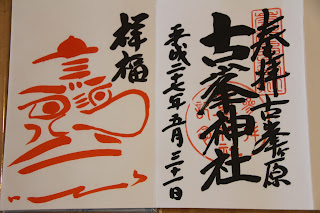If you check places to visit in Japan, you might notice that some of the recommended places are shrines and temples. They are so embedded to our culture and resemles what we are and where we came from. A goshuin is one of a token of your visit to shrine and temple and it is in some way artistic as well.
1. What is Goshuin?
It's easier to show it rather than to explain it. The below is the one from Meiji Jingu.
 |
| Meiji Jingu |
It started as a proof of dedicating a Buddist scripture manuscript to a temple. In Edo-period, when average people got the luxury of travel, they chose famous temples as places to visit and enjoy. Around then it gradually became that they do not require to turn in manuscripts but rather just visiting and praying at those places. And this custom spread to shrines.
At present, depending on the fractions or the size of the places but most shrines and temples where tourists go have one or several. Goshuin lovers such as me visit various temples and shrines around Japan to enjoy the sites, pray for you and your family's happiness and collect goshuins. In sum, a goshuin lovers are collectmanias.
2. What are the types of Goshuins?
Goshuins can be largely separated into two types. Ones from shrines and ones from temples. A goshuins of shrines tends to be simple. Usually, it has the name of a shrine either in a red seal or in an ink brush.
 |
| Atsuta Jingu |
 |
| Kumano Hongu |
 |
| Karasumori Jinja |
The above left is Atsuta Jingu in Nagoya, one of the three emperial treasures Kusanagi sword is enshrined. The middle is one from Kumano Hongu in Kumano, named the world heritage in 2004. The colorful one on the right is Karasumori Jinja in Shinbashi, not a big shrine but famous for this unique goshuin.
There are exceptions. Furumine Jinjya in Tochigi has a picture of tengu.
 |
| Furumine Jinja |
In comparison, goshuins of temples have more variations. What you typically see is either a special name of the building in the temples or a principle image worshipped in that temple.
 |
| Yakushi-nyorai |
 |
| Ruriden |
For example, the above left is from Yakushi-ji in Nara and the main icon Yakushi-nyorai, Bhaiṣajya-guru in sanscrit, is written in the center. The red seal behind is a medicine pot which is a iconic motif carried by Yakushi-nyorai. The right is from Kanei-ji in Ueno. The Ruriden is named after Ruri-ko which is sacred power of Yakushi-nyorai so they are basically saying the same thing.
 |
| Buji |
 |
| Namuamidabutsu |
The left one is from Yuten-ji in Meguro. What is stamped in center is namuamidabutsu, a popular buddhist mantra. This type of mantra or a powerful phrase or key message from buddhist scriptures. The right one is an example of those, is says buji (無事), one of the key message from Zen. It is from Butsuzan-ji in Yufuin. To be honest, I cannot read this as buji. It has been so abstracted and some goshuins seem to be more than just a token of visit but rather an art.
3. Where can you get Goshuins?
It depends on shrine by shrine, temple by temple. Usually you could either find them at the main building, a separate side building where office of such shrine/temple sits or a hut specially designed to provide goshuins.
4. What is Goshuin-cho?
A Goshuin-cho is a notebook which is designed to collect goshuins. You can purchase it from Goshuin book stores or some stationary stores but it is much handy and fun to get it at shrines and temples.
Some shrines and temples have its own design goshuin-cho decorated with its traditional symbols or treasures. These goshuin-cho themselves could be the collectors' item. As of now, I am still behaving myself ....
You can use both sides of goshuin-cho. It is spectacular to see goshuins filling every pages.
The right goshuin-cho is from Kumano Hongu. It has a distinctive garnishment in the main building and a three leg crow which is worshipped as a messenger of Kumano-Gongen god on it.
5. What are the rule in getting one?
There is only one rule of thumb. Pray to get one. Goshuin is a token of your visit and pray at those places. No need to be official in any way, put your hand together, close your eyes and just say hello or thank the god in your heart. That's good enough.6. How much is a goshuin?
It depends but for the most part it is 300 yen per goshuin. If it is complex or colorful it might be 500 yen. Goshuin-cho also depends but it is roughly around 1,000 yen to 2,000 yen.
Perhaps it would be interesting to try collecting goshuin as your memoir of your travel to Japan.

